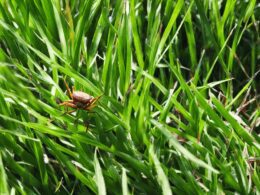If you’re looking to achieve a lush green lawn in no time, you’ve come to the right place. In this article, we’ll share expert tips and techniques to help you speed up grass growth and create a beautiful lawn that you can enjoy all season long.
By following these tips for faster grass growth, you’ll learn how to choose the right seed, prep the soil, sow and feed the grass, provide proper water and protection, and mow correctly. These steps will help you create the perfect conditions for your grass to thrive and grow quickly.
To get started, let’s explore the first step in achieving a faster-growing lawn: choosing the right seed.
Choosing the right seed is crucial for promoting fast and healthy grass growth. In the next section, we’ll discuss the different types of grass seed and help you determine the best option for your lawn.
Choose the Right Seed
Not all grass seed is the same. Depending on where you live, you’ll need to choose between cool season grass or warm season grass. Cool season grasses are best suited for regions with large temperature swings, while warm season grasses thrive in warmer climates with less temperature variation.
Choosing the right grass seed is crucial for achieving optimal growth and a beautiful lawn. It’s important to consider the climate and weather conditions in your area when selecting the type of grass seed. Cool season grasses, such as Kentucky bluegrass and perennial ryegrass, are ideal for regions with cooler temperatures and more significant temperature variations. These grasses can withstand colder winters and still maintain their lush green appearance.
On the other hand, warm season grasses, including Bermuda grass, Zoysia grass, and St. Augustine grass, thrive in regions with hot summers and mild winters. They have a higher heat tolerance and are more resistant to drought.
To determine the appropriate grass seed for your area, consider the climate zone you live in and consult with local gardening experts or professionals. They can provide valuable insights and recommendations based on your specific location and needs.
Once you’ve determined the appropriate type of grass seed for your area, consider using high-performance brands like Scotts Turf Builder. Scotts Turf Builder offers premium grass seed that jumpstarts growth and helps protect against disease. Their wide variety of seed options ensures that you can find the perfect match for your lawn’s needs.
By choosing the right seed for your lawn, you can set the foundation for a healthy and vibrant grass growth, leading to a lush and inviting lawn.
Prep the Soil
Before sowing grass seed, it’s essential to prepare the soil properly. Follow these steps to ensure your soil is ready for grass growth:
- Remove existing grass, weeds, and rocks from the area. This will eliminate competition for the new grass and create a clean seedbed.
- If you notice any low spots in the soil, fill them in with soil or a lawn soil product. Having a level surface will promote even grass growth.
- If the soil is compacted, consider using a tiller to loosen it up. This will help create a loose and friable soil structure that allows the grass roots to penetrate deeply.
- Once the soil is prepared, use a rake to create a level seedbed. This will ensure even distribution of the grass seed and optimal seed-to-soil contact.
By following these steps, you’ll be preparing the soil in the best possible way, setting the stage for successful grass growth.
Seed and Feed
To promote fast grass growth and ensure a healthy lawn, proper fertilization is key. After sowing the grass seed, it’s important to apply a high-quality starter fertilizer. Consider using Scotts Turf Builder Starter Food for New Grass, which provides essential nutrients for optimal growth.
When using the fertilizer, be sure to follow the package instructions for seed coverage. This will help ensure that the grass receives the right amount of nutrients for vigorous growth. To ensure even distribution of the seed and feed, it is recommended to use a spreader.
A spreader helps achieve uniform coverage of the seed and fertilizer, preventing patchiness and uneven growth. For larger areas, a broadcast spreader is ideal, as it can cover a wide area efficiently. If you have a smaller space to cover, a hand spreader works well and allows for more precise application.
If you’re looking for a convenient option that combines seed and feed in one product, consider Scotts Turf Builder Rapid Grass Sun & Shade Mix. This all-in-one solution simplifies the process and can help accelerate grass growth.
Water and Protect the Grass
Newly seeded areas require consistent watering to promote germination and growth. To ensure the success of your new grass seed, it’s important to follow a gradual watering process. Start by misting the area to lightly dampen the top inch of soil until the seeds sprout. This initial misting will provide the necessary moisture for germination.
Once the grass seed has germinated, you’ll want to keep the top 2 inches of soil consistently moist. Lightly water the area regularly to maintain the moisture level and support the growth of the young grass.
As the grass develops its root structure, it’s crucial to water deeply to reach the top 6 to 8 inches of soil. This encourages the roots to grow deeper, making the grass more resilient and better equipped to handle drought conditions.
While watering is essential, it’s also important to protect your newly seeded grass from foot traffic and pets. Avoid stepping on or allowing pets to play on the grass for at least a month to prevent damage to the developing grass. This will give the roots a chance to establish themselves and strengthen the overall health of the grass.
Mow the Right Way
Proper lawn mowing is essential for maintaining a healthy and vibrant lawn. By following the right techniques, you can ensure optimal grass growth while avoiding weed infestation.
When it comes to mowing your lawn, timing is crucial. Start mowing when the grass reaches a height of around 3 inches. This height is the sweet spot where cutting the grass won’t put excessive stress on it.
To set up your mower correctly, choose a high setting to allow the grass to remain slightly longer. Removing more than one-third of the grass blades at a time can shock the turf and make it vulnerable to weed growth.
Remember, mowing too low is the perfect invitation for weeds to take over your lawn. By maintaining the right mower height, you not only prevent weed growth but also promote a more robust and healthier grass turf.
Choosing the Best Grass Type for Quick Growth
Selecting the right grass type for your region is essential for achieving fast grass growth. There are two main categories of grass: warm season grasses and cool season grasses. Let’s explore the characteristics of each to help you make an informed choice.
Warm Season Grasses
If you live in an area with hot weather, warm season grasses are your best bet for fast-growing grass. These grasses thrive in warm climates and have a rapid growth rate during the summer months. Some popular warm season grass types include:
- Bermuda grass: Resilient and drought-tolerant, Bermuda grass is known for its excellent heat tolerance and ability to recover quickly from damage.
- Buffalo grass: Buffalo grass is a low-maintenance option that requires minimal water and fertilizer. It grows well in areas with hot, dry summers.
- Centipede grass: Centipede grass is a low-maintenance grass type that forms a dense, weed-resistant lawn. It is ideal for areas with hot and humid climates.
Cool Season Grasses
Cool season grasses, on the other hand, thrive in cooler climates and are known for their fast growth during the spring and fall months. If you live in an area with colder temperatures, consider these cool season grasses:
- Perennial ryegrass: Perennial ryegrass is a popular choice for its quick establishment and ability to tolerate moderate foot traffic. It germinates rapidly and fills in bare spots quickly.
- Tall fescue: Tall fescue is known for its tolerance to various growing conditions, including shade and drought. It has a deep root system that helps it withstand stress and recover quickly.
- Kentucky bluegrass: Kentucky bluegrass is a versatile grass type known for its dense, lush growth. It thrives in cool weather and has excellent wear tolerance.
By selecting the appropriate grass type for your area, whether it’s a fast-growing warm season grass or a cool season grass that flourishes in cooler climates, you can ensure faster and more successful grass growth, giving your lawn the lush, green appearance you desire.
Will Using Liquid Fertilizer Help Speed Up Grass Growth?
Using the best liquid fertilizer for grass can definitely help speed up grass growth. Liquid fertilizers are quickly absorbed by the grass, providing essential nutrients and promoting healthy and lush growth. With the right application, you can expect to see faster results and a greener, more vibrant lawn.
Conclusion
By implementing the following tips and techniques, you can speed up the grass growth process and achieve a lush green lawn. The key is to start by selecting the right seed for your specific climate and region. Choose between cool season grasses, such as perennial ryegrass and Kentucky bluegrass, for cooler climates or opt for warm season grasses like Bermuda grass and Centipede grass if you live in a hotter region.
Prepping the soil is another crucial step. Clear the area of existing grass, weeds, and rocks, and level the seedbed to ensure proper seed germination. After sowing the seed, fertilize with a high-quality starter fertilizer to nourish the new grass and boost growth. Brands like Scotts Turf Builder offer excellent options for both seed and fertilizer.
Remember to water your newly seeded lawn consistently and gradually to promote germination and establishment. Protect the grass from foot traffic and pets until it has fully matured. Once the grass reaches the appropriate height, mow it correctly by setting your mower to a higher setting and avoiding the removal of more than one-third of the grass blades.
With patience, dedication, and these expert tips, your lawn will transform into a vibrant and inviting space, providing you with the beautiful, lush green lawn you’ve always desired.










